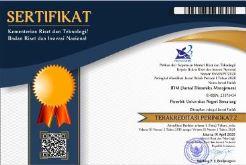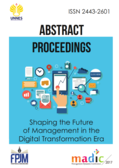Effect of Investment Fraud on Individuals’ Risk Preference and Investment Portfolio
Abstract
Keywords
Full Text:
PDFReferences
Alserda, G. A. G., Dellaert, B. G. C., Swinkels, L., & van der Lecq, F. S. G. (2019). Individual Pension Risk Preference Elicitation and Collective Asset Allocation with Heterogeneity. Journal of Banking & Finance, 101, 206–225.
Ananta, Y. (2019). Total Kerugian Akibat Investasi Bodong Tembus Rp 88,8 Triliun. Available at: https://www.cnbcindonesia.com/tech/20190405104517-37-64820/total-kerugian-akibat-investasi-bodong-tembus-rp-888-triliun.
Ansori, M. (2020). Metode penelitian kuantitatif Edisi 2. Airlangga University Press.
Borodin, A., Tvaronavičienė, M., Vygodchikova, I., Panaedova, G., & Kulikov, A. (2021). Optimization of the Structure of the Investment Portfolio of High-Tech Companies Based on the Minimax Criterion. Energies, 14(15), 4647.
Bosley, S. A., Bellemare, M. F., Umwali, L., & York, J. (2019). Decision-Making and Vulnerability in a Pyramid Scheme Fraud. Journal of Behavioral and Experimental Economics, 80, 1–13.
Bossler, A. M., Holt, T. J., Cross, C., & Burruss, G. W. (2020). Policing Fraud in England and Wales: Examining Constables’ and Sergeants’ Online Fraud Preparedness. Security Journal, 33(2), 311–328.
Brenner, L., Meyll, T., Stolper, O., & Walter, A. (2020). Consumer Fraud Victimization and Financial Well-being. Journal of Economic Psychology, 76.
Chen, C., & Zhou, Y. (2018). Robust Multiobjective Portfolio with Higher Moments. Expert Systems with Applications, 100, 165–181.
Deb, S., & Sengupta, S. (2020). What Makes the Base of the Pyramid Susceptible to Investment Fraud. Journal of Financial Crime, 27(1), 143–154.
Figge, F., Thorpe, A. S., & Manzhynski, S. (2021). Between You and I: a Portfolio Theory of the Circular Economy. Ecological Economics, 190, 107190.
Hamutoglu, N. B., Topal, M., & Gezgin, D. M. (2020). Investigating Direct and Indirect Effects of Social Media Addiction, Social Media Usage and Personality Traits on FOMO. International Journal of Progressive Education, 16(2), 248–261.
Kettlewell, N. (2019). Risk Preference Dynamics Around Life Events. Journal of Economic Behavior & Organization, 162, 66–84.
Kurniawan, W. A., & Dewanti, P. W. (2020). Pengaruh Promotion Motivational System, Prevention Motivational System dan Risk Preference terhadap Pembentukan Portofolio Investasi Berisiko. Nominal: Barometer Riset Akuntansi Dan Manajemen, 9(1), 124–142.
Lestari, N. P. (2021). Simulation of Optimal Portfolio Using Single Index Model and Markowitz Model on Lq-45 Index Shares For 2018. JBMP (Jurnal Bisnis, Manajemen Dan Perbankan), 7(1), 1–48.
Lokanan, M. E., & Liu, S. (2020). The Demographic Profile of Victims of Investment Fraud: an Update. Journal of Financial Crime, 28(3), 647–658.
Mittal, S., Bhattacharya, S., & Mandal, S. (2021). Characteristics Analysis of Behavioral Portfolio Theory in the Markowitz Portfolio Theory Framework. Managerial Finance, 48(2), 277–288.
Momen, O., Esfahanipour, A., & Seifi, A. (2020). A Robust Behavioral Portfolio Selection: Model with Investor Attitudes and Biases. Operational Research, 20(1), 427–446.
Niu, G., Zhou, Y., & Gan, H. (2020). Financial Literacy and Retirement Preparation in China. Pacific-Basin Finance Journal, 59, 101262.
Sarriá, E., Recio, P., Rico, A., Díaz-Olalla, M., Sanz-Barbero, B., Ayala, A., & Zunzunegui, M. V. (2019). Financial Fraud, Mental Health, and Quality of Life: a Study on the Population of the City of Madrid, Spain. International Journal of Environmental Research and Public Health, 16(18), 3276.
Sekaran, U., & Bougie, R. (2020). Research Method For Business: A Skill Building Approach. John Wiley & Sons Ltd.
Yao, Z., & Rabbani, A. G. (2021). Association between Investment Risk Tolerance and Portfolio Risk: the Role of Confidence Level. Journal of Behavioral and Experimental Finance, 30, 100482.
View Counter: Abstract - 629 and PDF - 1189
Refbacks
- There are currently no refbacks.





